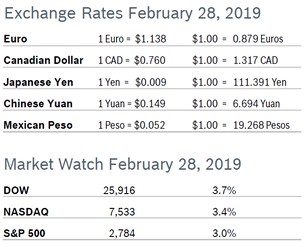|
The markets rose for the second consecutive month, cheered by positive progress on trade issues, low unemployment, moderating mortgage rates and better-than-expected GDP. Consumer Confidence Rises to 131.4 The New York-based Conference Board’s Consumer Confidence Index rebounded in February, rising to 131.4 after falling to 120.2 in January, according to the Conference Board’s latest survey. The Present Situation Index, which is based on consumers’ assessment of current business and labor market conditions, rose to 173.5 after dropping to 169.6 in January. The Expectations Index, which is based on consumers’ short-term outlook for income, jumped 14 points to 103.4 after falling sharply in January. The index is still below the peak of 137.9 reached last October. Economists note that a level of 90 indicates that the economy is on solid footing and a level of 100 or more indicates growth. Analysts caution that the real driver behind consumer spending is income growth and that labor market trends are a more accurate predictor of consumer behavior. Consumer Spending Drops 0.5% Consumer spending dropped 0.5% in December after rising an upwardly revised 0.6% in November. It was the biggest decline in consumer spending since September 2009. Core consumer spending fell 0.6% in December after rising 0.5% in November. Spending on goods dropped 1.9%, while spending on services edged up 0.1%. The Commerce Department released January personal income but did not publish January consumer spending or other stats because the collection and processing of retail sales data was delayed by the 35-day government shutdown that ended January 25. Personal income slipped 0.1% in January after jumping 1.0% in December. It was the first decline in personal income since November 2015. Savings in December increased to $1.2 trillion, the highest level since December 2012, and the saving rate jumped to a three-year high of 7.6%. The personal consumption expenditures (PCE) price index excluding food and energy rose 0.2% in December after a similar gain in November, leaving the year-over-year increase at 1.9%, still slightly below the Fed’s inflation target of 2.0%. Consumer Prices Flat The Consumer Price Index (CPI) was flat in January after falling 0.1% in December. The CPI rose 1.6% over the past twelve months, down from a 1.9% annual increase in December. Core inflation, which excludes food and energy, rose 0.2% for the fourth consecutive month and was up 1.9% from January 2018. Declining energy prices offset price growth in other major categories and held down overall inflation. Muted inflation has allowed the Fed to take a breather from raising short-term rates. The strengthening dollar is also depressing inflation. Unemployment Drops to 3.8% The unemployment rate dropped to 3.8% in February after rising to 4% in January, but the economy added just 20,000 new jobs, well below expectations. However, job gains for January were revised up to 311,000, bringing the three-month average to 186,000 new jobs. Some of the drop in unemployment was due to federal workers being back on the job after the end of the shutdown. Average hourly earnings rose 0.4% in February after growing just 0.1% in January. Earnings were up 3.4% year over year. With wage growth strengthening and more people employed, analysts expect consumer spending to remain solid. Construction payrolls dropped by 31,000 jobs as February brought more normal winter weather after a mild January. The economy needs to create about 120,000 new jobs each month to keep up with growth in the working-age population. Durable Goods Rise 1.2% Durable goods orders rose 1.2% in December after rising an upwardly revised 1% in November. Economists had forecast a 1.4% increase in orders. The increase was primarily due to a jump in orders for automobiles and airplanes, but demand was weak in other key manufacturing segments. Core durable goods orders for non-defense capital goods excluding aircraft, widely regarded as a key indicator of business spending, fell 0.7% in December after falling an upwardly revised 1% in November but was up a healthy 6.1% for the full year. Nondefense capital goods shipments, which factor into GDP, rose 0.8% in December after rising a downwardly revised 1% in November. The durable goods report is volatile and often subject to sharp revisions. Chicago PMI Rises to 64.7 The Chicago Purchasing Managers’ Index (PMI) rose 8 points to 64.7 in February after falling to 56.7 in January. It was the 25th consecutive month the PMI was above 50, the level that indicates growth. Four of the five components of the Index rose, with only Supplier Deliveries falling. New Orders rose 15.2 points, Production rose 8.5 points to a six-month high and Order Backlogs rose 5.6 points. Prices Paid posted the first increase in seven months, rising 6.6% on a year-over-year basis. The panelists were asked how another interest rate hike would impact their business. Just under 49% of firms thought it would have a negative impact, while 46.7% thought it would not impact their business at all. However, 42.6% of firms said the lack of agreement on trade issues had negatively impacted their business. Overall, firms remain optimistic about their business prospects. Wholesale Prices Fall 0.1% The Producer Price Index (PPI) fell 0.1% in January after falling 0.2% in December and was up 2.5% from January 2018. Core producer prices, which exclude food, energy and trade services, rose 0.3% in January after being flat in December and were up 2.6% from January 2018. The Labor Department said that sharp drops in food and energy prices more than offset rising prices for trade services, which advanced 0.8%, accounting for more than 80% of the total increase in prices. Q4 GDP Grows 2.6% GDP growth slowed to 2.6% in the fourth quarter after slowing to 3.4% in the third quarter, according to the Commerce Department. Growth was better than expectations of 2.3%. The GDP report was delayed by the government shutdown. The Commerce Department said they could not quantify the full effects of the shutdown, but estimated the partial closure subtracted about one-tenth of a percentage point from Q4 growth. They also pointed out that source data used to develop the estimate is still incomplete and there may be further revisions. GDP grew 2.9% in 2018, the best performance since 2015 and much better than the 2.2% the economy grew in 2017. Growth in consumer spending increased at a strong 2.8% in the fourth quarter after growing 3.5% in the third quarter. Business fixed investment (BFI) spending grew a robust 6.2% in Q4 after growing just 2.5% in the third quarter. The construction component of BFI remained weak, with residential construction falling for the fourth consecutive quarter, due to rising home prices and higher mortgage rates. GDP growth is expected to slow further in the first quarter to 1.8% before picking up to 2.5% in the second quarter. The Congressional Budget Office (CBO) estimated that the 35-day government shutdown will cost the government about $3 billion and will shave about 0.4% from annualized GDP in the first quarter. Economists believe a big slowdown in China’s economy and slower growth in Europe are reducing demand for American exports and making companies more reluctant to begin long-term projects. Consumer spending accounts for more than two-thirds of US economic activity. Job Openings Hit Record High The number of job openings surged to 7.3 million jobs in December after falling to 6.9 million in November, according to the most recent Job Openings and Labor Turnover Survey (JOLTS). That lifted the job opening rate to 4.7% from 4.6% in November. Construction vacancies increased by 88,000 jobs. Hiring continued to lag job openings in December, rising to 5.9 million from 5.8 million in November. There were 1.2 job openings for every unemployed person in December. The labor market has enjoyed a record 100 consecutive months of job gains, but the growing shortage of workers is expected to slow job growth down to about 150,000 jobs per month. The increase in job openings caused economists to worry that a shortage of workers could hurt the economic expansion that has now lasted for 9 1/2 years, making it the second longest expansion on record. The JOLTS report is one of the Fed’s preferred economic indicators. Fed Patient on Interest Rates The Fed stated that they can be patient as there is no need to raise rates right now. Fed Chairman Jerome Powell told the Senate Banking Committee that the Fed has been trying to decipher conflicting signals, including disappointing retail sales and other economic indicators that have been below expectations that are in contrast with steady hiring, wage growth and ongoing low unemployment. The Banking Committee did not push back as they have in the past, and no one suggested that the central bank was flirting with inflation or financial risks by leaving rates too low. The Fed raised rates four times in 2018 and has vowed to be patient this year until data suggests action needs to be taken. Wells Fargo believes that another rate hike will eventually ensue this year, but the Fed will then remain on the sidelines through much of 2020. They also forecast that real GDP will grow at an annualized rate between 2.0% and 2.5% this year. In addition, the very low unemployment rate will continue to put some upward pressure on wage inflation. The Fed raised rates four times in 2018 and had originally penciled in two increases for this year. Fed Chairman Jerome Powell’s statement is noteworthy because he has long favored a more aggressive outlook for monetary policy. Budget Deficit Grows The federal budget deficit totaled $13.5 billion in December, pushing the deficit for the first three months of the budget year up 41.8% from the same period the previous year. Tax revenue is up just 0.2%, reflecting the impacts of the tax cuts passed in 2017. The deficit is expected to total $897 billion in 2019. Workforce Advisory Board Formed The White House named prominent business execs to its newly formed workforce-policy advisory board, including the leaders of Home Depot, Walmart, IBM, Apple and Visa as well as education and labor officials. The 25-member board was established by an executive order in July that created the National Council for the American Worker. The first attempts to create the council fell apart after business leaders disagreed with President Trump’s handling of the white-supremacist rally in Charlottesville, Virginia in August 2017. China Tariffs Delayed President Trump tweeted out the news that he was delaying the tariffs due to take effect March 1 because trade negotiations with China have been very productive, and he plans to meet with Chinese President Xi Jinping at Trump’s resort in Mar-a- Lago, Florida to hammer out a final agreement. Recession in 2021? A majority of US economists expect the country to go into a recession by late 2021, according the most recent survey by the National Association of Business Economics (NABE). Their survey of 300 economists showed that 10% believe the US could go into recession this year, 42% believe a recession will begin in 2020 and 25% expect the contraction to begin in 2021. Most economists expect the Fed to raise interest rates once or twice this year. Most are concerned about the impact of tariffs and the US budget deficit, which could exceed 4% of GDP this year. © Robert Bosch Tool Corporation. All rights reserved, no copying or reproducing is permitted without prior written approval.
Comments are closed.
|
|








